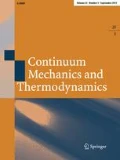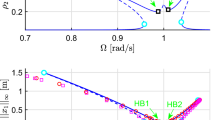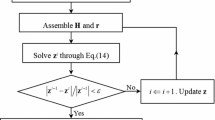Abstract
The destabilization effect of damping on a class of general dynamical systems is discussed. The phenomenon of jump in the critical value of the bifurcation parameter, in passing from undamped to damped system, is view in a new perspective, according to which no discontinuities manifest themselves. By using asymptotic analysis, it is proved that all subcritically loaded undamped systems are candidate to become unstable, provided a suitable damping matrix is added. The mechanism of instability is explained by introducing the concept of modal dampings, as the components of the damping forces along the unit vectors of a non-orthogonal eigenvector basis. Such quantities can change sign while the load changes the eigenvectors of the basis, thus triggering instability. A paradigmatic, non-physical, minimal system has been built up, admitting closed-form solutions able to explain the essence of the destabilizing phenomenon. Series expansions carried out on the exact solution give information on how to deal more complex systems by perturbation methods.
Similar content being viewed by others
References
Ryu B.R., Katayama K., Sugiyama Y.: Dynamic stability of Timoshenko columns subjected to subtangential forces. Comput. Struct. 68, 499–512 (1998)
Langthjem M.A., Sugiyama Y.: Dynamic stability of columns subjected to follower loads: a survey. J. Sound Vib. 238, 809–851 (2000)
Mazidi A., Fazelzadeh S.A., Marzocca P.: Flutter of aircraft wings carrying a powered engine under roll maneuver. J. Aircr. 48, 874–883 (2011)
Fazelzadeh S.A., Mazidi A.: Nonlinear aeroelastic analysis of bending-torsion wings subjected to a transverse follower force. ASME J. Comput. Nonlinear Dyn. 6(3), 031016 (2011)
Fazelzadeh S.A., Eghtesad M., Azadi M.: Buckling and flutter of a column enhanced by piezoelectric layers and lumped mass under a follower force. Int. J. Struct. Stab. Dyn. 10, 1083–1097 (2010)
Andreaus U., dell’Isola F., Porfiri M.: Piezoelectric passive distributed controllers for beam flexural vibrations. J. Vib. Control 10, 625–659 (2004)
Maurini C., dell’Isola F., Del Vescovo D.: Comparison of piezoelectronic networks acting as distributed vibration absorbers. Mech. Syst. Signal Process. 18, 1243–1271 (2004)
dell’Isola F., Vidoli S.: Continuum modelling of piezoelectromechanical truss beams: an application to vibration damping. Arch. Appl. Mech. 68, 1–19 (1998)
Lerbet J., Kirillov O.N., Aldowaji M., Challamel N., Nicot F., Darve F.: Additional constraints may soften a non-conservative structural system: Buckling and vibration analysis. Int. J. Solids Struct. 50(2), 363–370 (2013)
Lerbet J., Aldowaji M., Challamel N., Nicot F., Prunier F., Darve F.: P-positive definite matrices and stability of nonconservative systems. Z. Angew. Math. Mech. 92(5), 409–422 (2012)
Wang L.: Flutter instability of supported piped conveying fluid subjected to distributed follower forces. Acta Mech. Sin. 25, 46–52 (2012)
Katsikadelis J.T., Tsiatas G.C.: Non-linear dynamic stability of damped Beck’s column with variable cross-section. Int. J. Nonlinear Mech. 42, 164–171 (2007)
dell’Isola F., Madeo A., Seppecher P.: Boundary conditions at fluid–permeable interfaces in porous media: a variational approach. Int. J. Solids Struct. 46, 3150–3164 (2009)
Madeo A., Gavrilyuk S.: Propagation of acoustic waves in porous media and their reflection and transmission at a pure-fluid/porous-medium permeable interface. Eur. J. Mech. A-Solid 22, 897–910 (2010)
Rosi G., Giorgio I., Eremeyev V.A.: Propagation of linear compression waves through plane interfacial layers and mass adsorption in second gradient fluids. Z. Angew. Math. Mech. 93(12), 914–927 (2013)
Luongo, A., Ferretti, M.: Can a semi-simple eigenvalue admit fractional sensitivities? Appl. Math. Comp., doi:10.1016/j.amc.2014.01.178 (2014)
Seyranian A.P., Di Egidio A., Contento A., Luongo A.: Solution to the problem of Nicolai. J. Sound Vib. 333(7), 1932–1944 (2014)
Luongo, A., Ferretti, M., Seyranyan, A.P.: Damping effects on stability of the compressed Nicolai beam. Accepted for publication in M&MoCS J (2014)
Crandall, S.H.: The effect of damping on the stability of gyroscopic pendulums. In: Casey, J., Crochet, M.J. Theoretical, experimental, and numerical contributions to the mechanics of fluids and Solids., pp. 761–780. Birkhäuser Basel, (1995)
Hoveijn I., Ruijgrok M.: The stability of parametrically forced coupled oscillators in sum resonance. Z. Angew. Math. Phys. 46, 384–392 (1995)
Moffatt H.K., Shimomura Y., Branicki M.: Dynamics of an axisymmetric body spinning on a horizontal surface. I. Stability and the gyroscopic approximation. Proc. R. Soc. Lond. A 460, 3643–3672 (2004)
Kirillov O.N.: Gyroscopic stabilization in the presence of nonconservative forces. Dokl. Math. 76(2), 780–785 (2007)
Kimball A.L.: Internal friction theory of shaft whirling. Gen. Electr. Rev. 27, 224–251 (1924)
Smith D.M.: The motion of a rotor carried by a flexible shaft in flexible bearings. Proc. R. Soc. Lond. A 142, 92–118 (1933)
Kapitsa P.L.: Stability and passage through the critical speed of the fast spinning rotors in the presence of damping. Zh. Tech. Phys. 9(2), 124–147 (1939)
Ziegler H.: Die stabilitätskriterien der elastomechanik. Ing. Arch. 20, 49–56 (1952)
Beck M.: Die knicklast des einseitig eingespannten, tangential gedrückten stabes. Z. Angew. Math. Phys. 3, 225–228 (1952)
Bottema O.: On the stability of the equilibrium of a linear mechanical system. Z. Angew. Math. Phys. 6, 97–104 (1955)
Bottema O.: The Routh–Hurwitz condition for the biquadratic equation. Indagat. Math. 18, 403–406 (1956)
Bolotin V.V.: Nonconservative problems of the theory of elastic stability. Macmillan, New York (1963)
Herrmann G., Jong I.C.: On the destabilizing effect of damping in nonconservative elastic systems. ASME J. Appl. Mech. 32(3), 592–597 (1965)
Herrmann G.: Stability of equilibrium of elastic systems subjected to non-conservative forces. Appl. Mech. Revs. 20, 103–108 (1967)
Leipholz H.: Über den einfluss der dämpfung bei nichtkonservativen stabilitätsproblemen elastischer stäbe. Ing. Arch. 33(5), 308–321 (1964)
Plaut R.H., Infante E.F.: The effect of external damping on the stability of Beck’s column. Int. J. Solids Struct. 6(5), 491–496 (1970)
Plaut R.H.: A new destabilization phenomenon in nonconservative systems. Z. Angew. Math. Mech. 51(4), 319–321 (1971)
Kirillov O.N., Verhulst F.: Paradoxes of dissipation-induced destabilization or who opened Whitney’s umbrella. Z. Angew. Math. Mech. 90(6), 462–488 (2010)
Seyranian, A.P., Mailybaev, A.A.: A remark to the paper by O.N. Kirillov and F.Verhulst “Paradoxes of dissipation-induced destabilization or who opened Whitney’s umbrella?” [Zamm 90, no. 6, 462–488 (2010)], Z. Angew. Math. Mech. 92(3), 253–253 (2012)
Seyranian, A.P., Mailybaev, A.A.: Authors’ reply to “A remark to the paper by O.N. Kirillov and F. Verhulst “Paradoxes of dissipation-induced destabilization or who opened Whitney’s umbrella?” [Zamm 90, no. 6, 462-488 (2010)], Z. Angew. Math. Mech. 92 (3), 254–254 (2012)
Lahiri A., Roy M.S.: The Hamiltonian Hopf bifurcation: an elementary perturbative approach. Int. J. Nonlinear Mech. 36(5), 787–802 (2001)
Whitney H.: The general type of singularity of a set of 2n-1 smooth functions of n variables. Duke Math. J. 10, 161–172 (1943)
Kirillov O.N.: A theory of the destabilization paradox in non-conservative systems. Acta Mech. 174(3-4), 145–166 (2005)
Kirillov O.N., Seyranian A.P.: The effect of small internal and external damping on the stability of distributed non-conservative systems. J. Appl. Math. Mech. 69, 529–552 (2005)
Seyranian A.P., Malyabev A.A.: Multiparameter stability theory with mechanical applications. World Scientific, Singapore (2003)
Luongo A., Paolone A., Di Egidio A.: Sensitivities and linear stability analysis around a double zero eigenvalue. AIAA J. 38(4), 702–710 (2000)
Walker J.A.: A note on stabilizing damping configurations for linear nonconservative systems. Int. J. Solids Struct. 9(12), 1543–1545 (1973)
Banichuk N.V., Bratus A.S., Myshkis A.D.: Stabilizing and destabilizing effects in non-conservative systems. J. Appl. Math. Mech. 53(2), 158–164 (1989)
Kirillov O.N., Seyranian A.P.: Stabilization and destabilization of a circulatory system by small velocity-dependent forces. J. Sound Vib. 283(3-5), 781–800 (2005)
Guckenheimer J., Holmes P.: Nonlinear oscillations, dynamical systems and bifurcation of vector fields. Springer, Berlin (1983)
Luongo A.: Eigensolutions sensitivity for nonsymmetric matrices with repeated eigenvalues. AIAA J. 31(7), 1321–1328 (1993)
Luongo A.: Free vibrations and sensitivity analysis of a defective two degree-of-freedom system. AIAA J. 33(1), 120–127 (1995)
Luongo A.: Eigensolutions of perturbed nearly defective matrices. J. Sound Vib. 185(3), 377–395 (1995)
Author information
Authors and Affiliations
Corresponding author
Additional information
Communicated by Angela Madeo and Francois Nicot.
Rights and permissions
About this article
Cite this article
Luongo, A., D’Annibale, F. A paradigmatic minimal system to explain the Ziegler paradox. Continuum Mech. Thermodyn. 27, 211–222 (2015). https://doi.org/10.1007/s00161-014-0363-8
Received:
Accepted:
Published:
Issue Date:
DOI: https://doi.org/10.1007/s00161-014-0363-8




